Displaying 111 - 120 of 1087
In order to address the dearth of information in less developed regions, this article aims to provide an insight into the increased cases of child abuse in Uganda during the COVID‐19 pandemic.
This study examined the recurrent maltreatment of American Indian children in foster and adoptive homes, specifically the physical, emotional, sexual, and spiritual abuse subtypes, as well as poly-victimization of American Indian children in comparison to their White peers.
This study, the largest of its kind in Canada, examines when and for whom recurring conditions of neglect were most likely to occur for all children involved with child protection in the province of Quebec over a span of fifteen years.
A Constituição da República de Moçambique consagra a educação como um direito e dever fundamental de cada criança, que deve ser oferecida num ambiente seguro, propiciando a aprendizagem.
The current study seeks to address the lack of literature including voices of mental health clinicians regarding their work and clients in the child welfare system by exploring clinicians’ views on the issue of child maltreatment and CPS-involved parents’ parenting.
The current study investigated the effects of parental emotional neglect on left-behind children’s externalizing problem behaviors, the mediating role of deviant peer affiliation, and the moderating role of beliefs about adversity in the association between parental emotional neglect and left-behind children’s externalizing problem behaviors.
The present study examined how emotional abuse and emotional neglect-exposure in adolescence uniquely related to psychological symptoms and social impairment.
More than 100 child participants across East Asia convened with government officials to discuss the increased instances of child violence experienced during COVID-19 at World Vision’s Asia Pacific Child Well-Being Learning Exchange forum on 18 November 2020.
This presentation - delivered by Marinus van IJzendoorn at a 18 November 2020 meeting of the Evidence for Impact Working Group, a working group of the recently launched Transforming Children's Care Global Collaborative Platform - presents evidence of the harmful impacts of institutionalization on children, demonstrates some of the benefits of deinstitutionalization for getting children back on track, and raises questions about gap-year volunteers working in orphanages.
The purpose of this study was to determine the (1) overall cost for implementing the Safe Environment for Every Kid (SEEK) model, (2) cost of implementation per child, and (3) cost per case of maltreatment averted.



